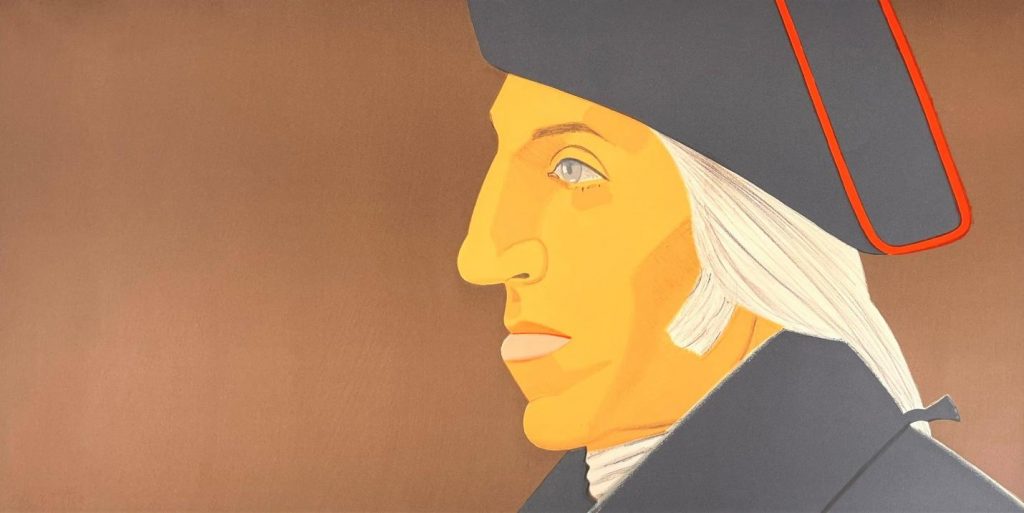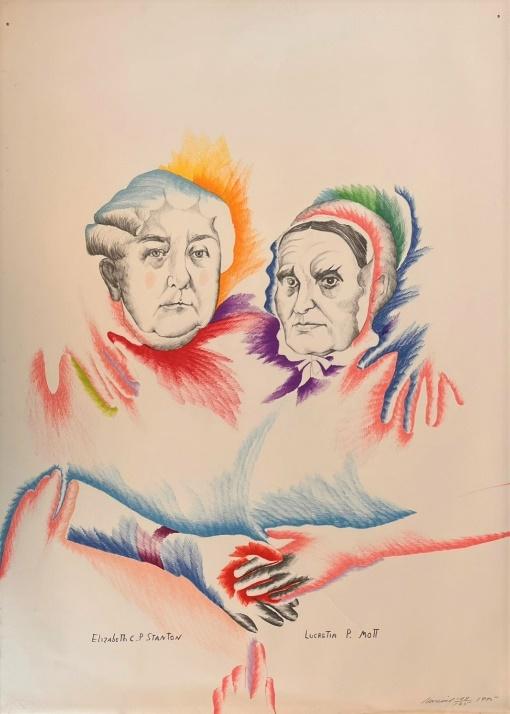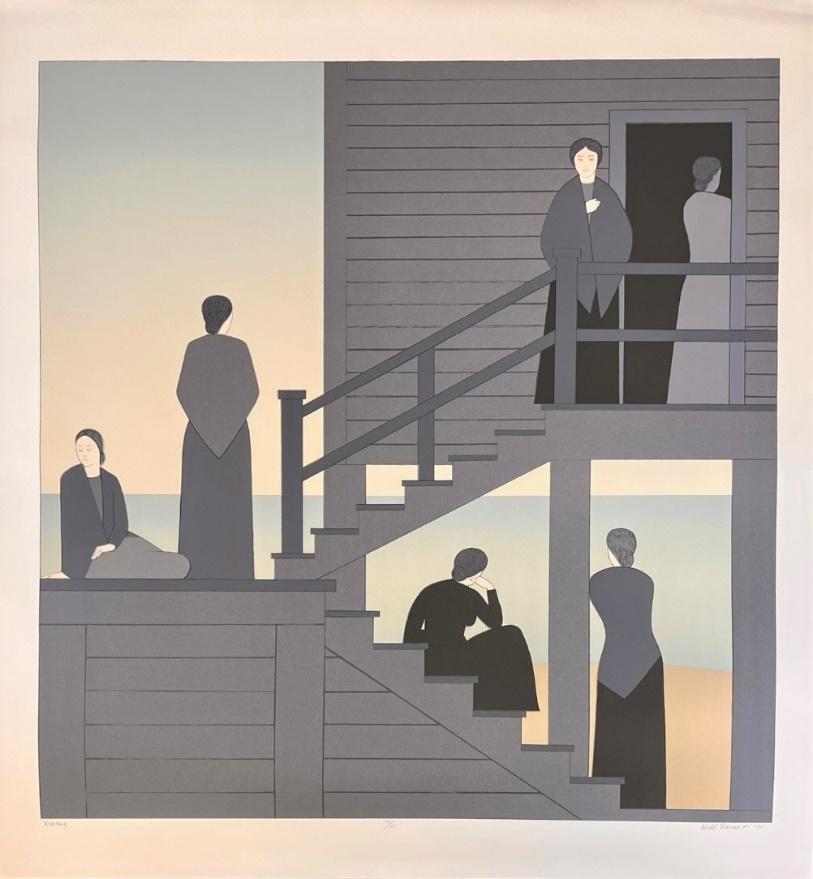Collection Close-Up: ‘Spirit of Independence’
By Elizabeth Coulter, curator of collections for the Delaware Division of Historical and Cultural Affairs
What does the spirit of Independence Day mean to you? The United States of America’s federal holiday commemorates the Declaration of Independence, which proclaimed liberation from Great Britain and established a government that protected fundamental rights for its citizens. This holiday often conjures concepts attached to the American identity including liberty, prosperity, freedom, democracy and justice.


In 1976, the bicentennial year of America, Lorillard Tobacco Company (founded 1760), of Kent Cigarettes, prompted 12 artists with the question “what does independence mean to you?” leading to the creation of the “Kent Bicentennial Portfolio: Spirit of Independence.” The company sponsored the series for $250,000 to not only celebrate the bicentennial by supporting the arts, but also to build its own image as a company.

Interestingly, this time was also referred to as the “BUYcentennial SELLabration,” a term coined by the leftist group The People’s Bicentennial Commission to raise awareness of the extreme consumerism and commercialization of Americana. During this time, the country was also grappling with inflation, the end of the Vietnam War, an energy crisis, the Women’s Liberation movement and the post-Civil Rights movement. The contemporary moment and their personal experiences greatly influenced each artist as they contemplated the meaning of independence in 1976. The series, or portfolio, of 12 prints was produced in a limited amount and donated to museum collections, including the one held by the division.
Fourth of July Still Life by Audrey Flack (B. 1931), a forerunner of photorealism, pictures the American flag, an engraved portrait of George Washington, a red-white-and-blue streamer and collectibles of a revolutionary figure, the Liberty Bell and a gilded American eagle. Operating in the tradition of still life painting that not only presents an artist’s skill, but also invokes a specific moment in time or a feeling, she studies the consumerist culture of the “BUYcentennial SELLabration” and the typical iconography associated with Independence Day. Similarly, Edward Ruscha’s (B. 1937) America Her Best Product — with a dense background of small dots of varying colors and the large, bold Futura font that reads “MADE IN U.S.A.” — considers similar themes. The phrase, an indicator of national pride that authenticates the source of a product, is also readymade and leads the viewer to question, what is America selling? These two works engage with themes of consumerism and the American identity through iconography, while other prints delve deeply into national icons.


Two works, George Washington by Alex Katz (B. 1927) and An Outline of History by Larry Rivers (1923-2002), reimagine founding father figures. Katz, known for his stylized cropped portraits, often rendered his colleagues, other artists, friends and family, though he was also inspired by popular culture. He worked in his typical approach to composition to portray George Washington (1732-1799) in a tricorn hat with a close-up, profile view against a brown monochrome background. Rather than the typical full-scale, monumental portrait of the founding father, he is pictured up close with a pensive expression. Rivers, known for a style that intersects abstract expressionism and pop art, created An Outline of History as a redacted and reinterpreted version of an 1801 painting by Robert Edge Pine (1730-1788) and Edward Savage (1761-1817), Congress Voting Independence. The title of Rivers’ work not only indicates the act of Congress outlining the Declaration of Independence, but also the artistic format of the colorful outlines of figures with lines labeling their names above their heads. The title could also allude to the history of founding fathers primarily recorded, taught and understood for generations of Americans.
Other national icons like Elizabeth Cady Stanton (1815-1902) and Lucretia Mott (1793-1880), abolitionists and activists for women’s rights, are pictured embracing one another in Women’s Equality by Marisol Escobar (1930-2016). Their faces are detailed in grayscale while Escobar renders the rest of their bodies in bright colors. The artist, a contributor to the pop art movement, also pictures her own hands on their shoulders, thereby including herself, a naturalized United States citizen born in France to Venezuelan parents, into the narrative.

Will Barnet (1922-2012) also explored his personal experience in his body of work, including this print Waiting. He grew up in Beverly, Massachusetts, a coastal whaling town. Women often watched the horizon anticipating their husbands’ return, and in the 1970s he studied this concept in his work, although he depicted the women in no specific time or place. This work features a still, quiet scene of six women sitting and standing outside a home on the coast. Three women face away from the viewer to stare out to sea, while three others look in different directions, contemplatively, leading the viewer to engage in a similar moment of stillness and reflection to consider what are they waiting for?
Whereas, Bicentennial Bandwagon by Red Grooms (B. 1937) assembles heavily coded images from American history to overstimulate the viewer and critique the concepts of “EQUALITY” and “PLENTY.” This jarring, energetic composition pictures a horse-drawn, palatial bandwagon with grotesque Americana caricatures and symbols on a dirt path in a field, while fireworks explode in the background. This chaotic, vaudeville-like display includes a football player wearing heels, King George and a stereotyped Native American facing off in front of the Liberty Bell, a racist caricature of a Black person driving the wagon, Betsy Ross sewing the American flag, and billowing yellow clouds reminiscent of napalm. His depictions simultaneously question labor, race, gender, capitalism, colonization and politics in America, and they require the viewer to consider how this type of imagery has impacted the cultural psyche over time.

Joseph Hirsch (1910-1981) also engages with America’s cultural consciousness in his The Boston Tea Party. Hirsch said, “The Boston Tea Party has, for me, the elements of wild paradox: what was outrageous vandalism two centuries ago, we today cherish nationally as a symbol of the free soul.” Hirsch imagines the scene of political protest and the first major act of rebellion of British rule over the colonies on December 16, 1773, at Griffin’s Wharf in Boston, Massachusetts, when American colonists dumped into the harbor 342 chests of tea imported by the British East India Company. Hirsch pictures two men on a ship in action, destroying and throwing tea overboard. Their dress alludes to historic accounts of colonists dressing in their interpretation of Tomahawk attire to not only disguise themselves, but to also emphasize the ethos of anti-colonialism for witnesses.


Another artist, Fritz Scholder (1937-2005), engaged with the lingering impact and complexities of fabricated imagery of Native people in his work Bicentennial Indian. Scholder, one-quarter Luiseño or Payómkawichum, at first chose not to portray Native people in his work because he resented images of the “noble savage” in mainstream culture. In 1967, he began his “Indian Series,” which challenged clichés and created a contemporary look of Native existence. This work features a Native person sitting with an American flag draped over his lap. His position simultaneously recalls one of Betsy Ross sewing the American flag and the dark history of incarcerated Native people made to wear American flags after colonizers forcibly removed their clothing. In doing so, he speaks in a visual vernacular of a common American revolution narrative to address another truth usually not mentioned in the context of American independence.

Jacob Lawrence (1917-2000) also worked to widen cultural understanding of images attached to American history through his body of work. He is best known for his Great Migration series that documented vignettes of life centered on the mass relocation of African Americans from the rural south to urban, industrialized midwestern and northeastern cities (1915-1950). His The 1920’s…The Migrants Cast Their Ballots, an extension of that series, features Black people of different ages waiting on line to vote. The interaction of the figures, rendered in a stylized, abstract manner, and the bright color palette of primary colors emphasize a celebration of agency and civic duty.
Two other artists utilized a similar color palette to rethink the imagery of the American flag. Liberty ’76 by pop artist Robert Indiana (1928-2018) features stars, stripes and a large, “76,” as well as text referencing freedom and liberty. The minimalist, balanced composition and its symbols represent the “American Dream.” While, Union Mixer by Colleen Browning (1918-2003), the classically trained figure painter, showcases her new vision of the American flag with various profiled faces. Browning noted, “all races, nationalities, and ages of women and men are united under the flag of the U.S.A. As an immigrant myself I am very conscious of the great ethnic variety that is subsumed under the word ‘American.'”


While the works within this series vary in aesthetics unique to each artist, they are unified by their thoughtful contemplations on the complexities of the American identity and the notion of independence. Though this series was created in 1976, and greatly influenced by the social and political climate, these works provoke themes still considered today.
As the Delaware Division of Historical and Cultural Affairs’ Curator of Collections, Elizabeth Coulter participates in developing and installing exhibitions, presenting educational programs, providing access to the collections, collaborating with partnering organizations and expanding the profile and use of the collections. She holds a Bachelor’s Degree in Art History and American Studies from Rutgers University and a Master’s Degree in Decorative Arts History from George Mason University and the Smithsonian Associates.


